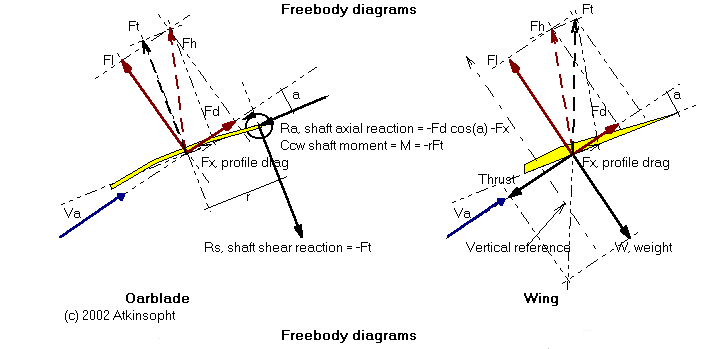
Figure 1

One wing, more efficient than another, has a higher ratio of lift to drag but the lift itself is never more nor less than that required to balance (sustain) the fixed weight of the aircraft, i.e., the lift for one wing (on that airplane) is the same as the lift for any other wing although not, perhaps, at the same airspeed or attack angle. If the weight of the plane is zero the lift of the wing is zero.
Similarly, one oarblade, more efficient than another, has more favorable lift and drag characteristics but the reaction on the water itself is never more nor less than that required (at any instant) to balance (sustain) the effort of the rower, i.e, the reaction at the water for one blade (for that rower) is the same as the reaction for any other blade although not, perhaps, at the same pull-thru or sweep speed. If the rower's effort is zero the lift of the blade is zero.
An oarshaft and blade left to drift through its stroke as the shell advances will automatically and continually induce the fluid angle of attack required to produce zero lift.
Thus, the lift and drag characteristics of an oarblade have no more effect on the rower's propulsive force than the lift characteristics of a wing have on the weight of an airplane- a given airplane wing in inverted flight has greatly changed aerodynamic characteristics; the airplane continues to fly (at a new speed and angle of attack); while its weight remains unchanged.
Grasping this counterintuitive aspect of oarblades is the key to understanding their behavior.
If propulsive force is unaffected by oarblade design, then what is?
It is the slip of the blade that is affected. Reducing blade slip increases blade efficiency; it increases the advance of the shell per sweep of the drive.
Wings differ from blades in another way. Owing to the forward motion of the airplane and its fixed wing the wing's attack angle is more or less always the same- except in extreme cases such as "mushing" in nose-up for a landing. The blade, on the other hand, is constrained by the oarlock and rower to follow a greatly varying path with respect to the water, manifesting attack angle changes through the entire 180 degree range.